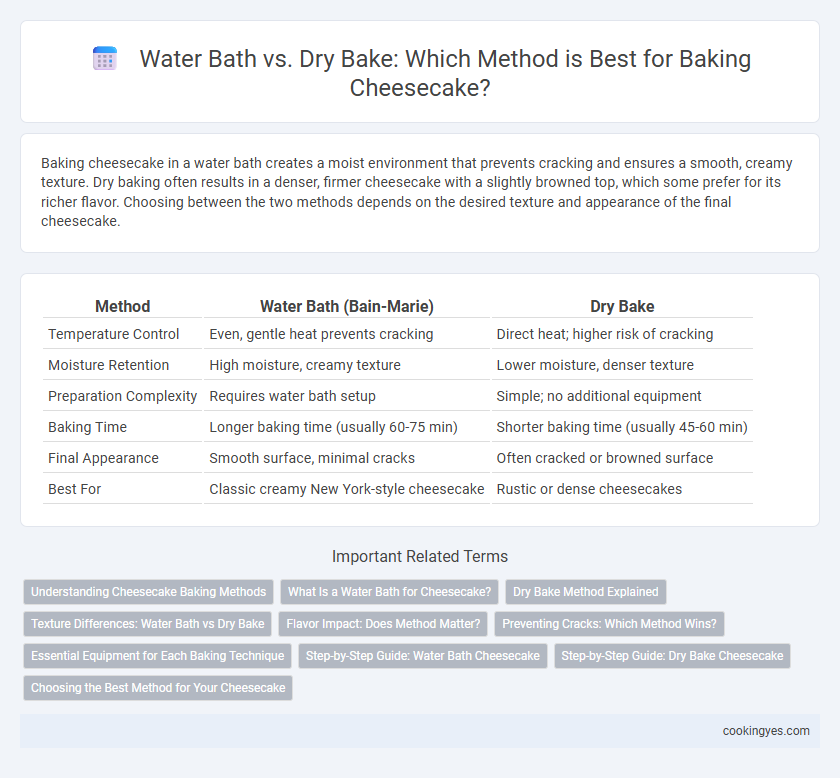Baking cheesecake in a water bath creates a moist environment that prevents cracking and ensures a smooth, creamy texture. Dry baking often results in a denser, firmer cheesecake with a slightly browned top, which some prefer for its richer flavor. Choosing between the two methods depends on the desired texture and appearance of the final cheesecake.
Table of Comparison
| Method | Water Bath (Bain-Marie) | Dry Bake |
|---|---|---|
| Temperature Control | Even, gentle heat prevents cracking | Direct heat; higher risk of cracking |
| Moisture Retention | High moisture, creamy texture | Lower moisture, denser texture |
| Preparation Complexity | Requires water bath setup | Simple; no additional equipment |
| Baking Time | Longer baking time (usually 60-75 min) | Shorter baking time (usually 45-60 min) |
| Final Appearance | Smooth surface, minimal cracks | Often cracked or browned surface |
| Best For | Classic creamy New York-style cheesecake | Rustic or dense cheesecakes |
Understanding Cheesecake Baking Methods
Water bath baking creates a moist, even heat environment that prevents cracking and ensures a smooth, creamy cheesecake texture. Dry baking exposes the cheesecake to direct oven heat, often resulting in a firmer texture with a denser crumb and a golden top. Choosing between water bath and dry bake methods depends on the desired texture and appearance, with water baths favored for delicate cheesecakes and dry baking suited to rustic, cheesecake varieties.
What Is a Water Bath for Cheesecake?
A water bath for cheesecake involves placing the cheesecake pan inside a larger pan filled with hot water during baking to ensure even heat distribution and prevent cracking. This method creates a moist baking environment, helping to maintain the cheesecake's creamy texture and smooth surface. Compared to dry baking, a water bath significantly reduces the risk of overcooked edges and a dry, crumbly crust.
Dry Bake Method Explained
The dry bake method for cheesecake involves baking the cake in a regular oven without surrounding it with water, resulting in a firmer texture and slightly denser crumb. This technique allows for a golden-brown top and caramelized edges, enhancing both flavor and presentation. It is especially suitable for cheesecakes with added fruits or toppings that require less moisture retention.
Texture Differences: Water Bath vs Dry Bake
Baking cheesecake in a water bath results in a creamier, smoother texture by providing gentle, even heat that prevents cracking and curdling. Dry baking exposes the cheesecake to direct oven heat, often producing a denser, firmer texture with a slightly browned surface. The moisture from the water bath slows baking, allowing proteins to set gradually, enhancing silkiness compared to the quicker, more rigid structure formed during dry baking.
Flavor Impact: Does Method Matter?
Water bath baking creates a moist environment that helps prevent cracking and promotes a smooth, creamy texture, enhancing the cheesecake's rich and velvety flavor profile. Dry baking often results in a denser, slightly drier texture with more pronounced caramelization on the crust, intensifying the overall taste but risking a less uniform interior. Ultimately, the water bath method preserves delicate flavors better, while dry baking can add a bolder, toasted note to the cheesecake.
Preventing Cracks: Which Method Wins?
Water bath baking creates a moist, gentle heat environment that effectively prevents cracks in cheesecake by maintaining even cooking and minimizing temperature fluctuations. Dry baking exposes the cheesecake directly to hot air, increasing the risk of drying out and cracking due to rapid, uneven heat distribution. For crack-free, smooth cheesecake surfaces, the water bath method is the optimal choice.
Essential Equipment for Each Baking Technique
Water bath baking requires a sturdy, deep roasting pan to hold hot water and a springform pan to prevent leaks, ensuring gentle, even heat distribution that minimizes cracking. Dry bake method necessitates high-quality non-stick or heavy-duty metal pans allowing direct oven heat with consistent structure and easy removal. Both techniques benefit from oven thermometers for precise temperature control and silicone mats or parchment paper to protect the cheesecake surface.
Step-by-Step Guide: Water Bath Cheesecake
Using a water bath for cheesecake baking ensures even heat distribution and prevents cracking by maintaining consistent moisture. Start by wrapping the springform pan in foil to avoid water leaks, then place it in a larger pan filled with hot water reaching halfway up the sides. Bake at a low temperature, monitoring water level halfway through to keep the environment moist for a creamy, smooth texture.
Step-by-Step Guide: Dry Bake Cheesecake
Dry bake cheesecake involves preparing the batter, pouring it into a springform pan, and baking at a moderate temperature without a water bath, typically around 325degF (163degC) for 45 to 60 minutes. Ensure the cheesecake is set around the edges but still slightly jiggly in the center to avoid cracking during cooling. Allow the cheesecake to cool gradually in the oven with the door slightly ajar before refrigerating for at least 4 hours to achieve a dense, creamy texture.
Choosing the Best Method for Your Cheesecake
Selecting the ideal baking method for cheesecake hinges on texture preferences and equipment availability; a water bath ensures gentle, even heat that minimizes cracks and creates a smooth, creamy texture, especially for custard-style cheesecakes. Dry baking suits denser, New York-style cheesecakes by delivering a firmer crumb and quicker bake time without added moisture. Understanding the impact of each method on moisture retention and structural integrity helps achieve the perfect balance between creamy softness and sliceability.
Water bath vs dry bake for cheesecake baking Infographic

 cookingyes.com
cookingyes.com